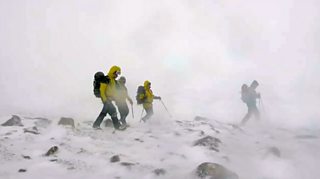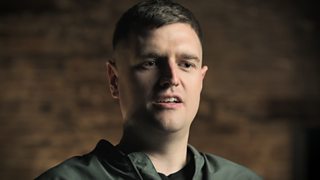ThereвҖҷs no such word as вҖҳdisabilityвҖҷ in Newton Dee, the village where everyone works together for the good of the community
Things are done a bit differently in Newton Dee.
In this residential Aberdeenshire community – part of the Camphill movement – people with learning disabilities and the people who care for them all live and work together.
Their homes are adjacent to a biodynamic farm, where they spend much of their time.

Keen gardener Katie shows off the fruit and veg grown in the Newton Dee garden
The food grown here is distributed around the houses in the village.
The Camphill movement
Karl König, an Austrian paediatrician, wanted to set up a community to help children with special needs.
In 1938, he and his students fled Nazi-occupied Austria and regrouped in Scotland. In 1940, the community set up a permanent base in Camphill Estate, just west of Aberdeen.
There are now over 100 Camphill community sites throughout the world.
In Camphill communities, there are no divisions between those who are assigned as carers and those who are seen as being cared for.
Everybody lives and works together for the good of the wider community.
Meet some Newton Dee residents

What you do becomes a big part of who you are
The support that Newton Dee’s carers provide is designed to maximise the independence of those receiving it and instil a sense of social identity.
Some of the care-givers live in the village and some come as day placements.
The farm is home to cows, pigs and chickens — meaning milk meat and eggs are all home-produced. There are also two gardens, which residents manage to supply fruit and vegetables for the village.
Emma works in the local café.

Camphill really, really brings out the best in peopleEmma, Newton Dee resident
One of her care-givers – or ‘house parents’ – said that Emma had flourished during her time in Newton Dee and that her confidence had evidently grown as a result of the supportive environment of the community.
Care-giver Ginny described the importance of identifying people’s strengths as well as their challenges — and to then support each resident accordingly.
The initiative is not seen as a passive process. Ginny expects care-receivers “to fulfil their task and their potential.”
“I guess it’s like a wider family”
Some of those who moved to Newton Dee to provide care expanded on how fulfilling the experience has been.
Jake, who lives with his own family and seven adults with additional support needs, said that life in the community “can be a lot of fun, but it can be quite demanding at the same time.”
Ginny added that the wider community were supportive and present for the initial stresses she and her husband felt when dealing with the steep learning curve of first living at Newton Dee.

Elizabeth introduces us to the animals that live on the Newton Dee farm
SheвҖҷs friendly with all of them but Karma the bull can sometimes get a bit too friendly.
Relationships at Newton Dee
The increased sense of identity and independence has meant that many Newton Dee residents have formed relationships.

Ally and Carla, Steph and Katy, and married couple John and Ingrid (pictured) all spoke about life as a couple in a Camphill community.
Ingrid first spotted John when he was out cycling. Her initial thought – “what a funny man” – eventually led to her getting down on one knee and proposing to him.
After an admittedly long engagement, John and Ingrid married.
Looking through photographs from the big day, John remembered Ingrid’s red dress fondly, as well as the delicious carrot cake!
After Ingrid delightedly reminded her husband how handsome he looked in his blue suit, the couple revelled at a shot of them kissing — their favourite photo of the day.
-
![]()
Village of Dreams
Documentary following a year in the life of a village where people with learning disabilities and the people who care for them live communally and work together.
Latest features from ҙуПуҙ«ГҪ Scotland
-
![]()
'Wild swimming helps me process the grief of losing my son'
The benefits of cold water therapy.
-
![]()
Winter adventures are appealing, but an expert advises caution
Trips in winter require particular knowledge and skills.
-
![]()
The rescuers: Why volunteers risk their lives in mountain emergencies
Landward meets members of the Cairngorm Mountain Rescue Team.
-
![]()
вҖҳLook for the lightвҖҷ вҖ“ practical tips to help you through another winter with SAD
Useful advice and tips to combat low moods at this time of year.
-
![]()
How you could be a binge drinker without even knowing
Binge drinking is classed as fewer units than many people may realise.
-
![]()
How chocolate biscuits and drama classes helped one man leave prison behind
The healing power of creativity.
-
![]()
'When people believe in you, itвҖҷs life-changing'
Author Graeme Armstrong revisits the man who helped turn his life around.
-
![]()
The 'breath-taking' display of US birds swept on to British soil
Recent storms have brought rare birds to our shores.
-
![]()
Six things we learned about Alan Cumming on Take the Floor (Spoiler: includes accordions)
The actor spoke to Take the Floor's Gary Innes.
-
![]()
How street gangs trap young men in a dangerous cycle of violence
The almost inescapable pull of life in a gang.
-
![]()
Why stylist Gok Wan believes there's no such thing as bad fashion
The fashion expert says we should stop following rules and do what feels right.
-
![]()
Is sending a CV still the right way to apply for a job?
They've been central to job applications for years, but are they worth it?




















